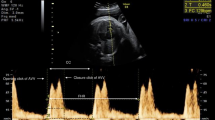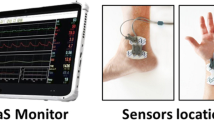Abstract
Purpose
The aim of the study is to compare maternal hemodynamic adaptations in gestational diabetes (GDM) versus healthy pregnancies.
Methods
A prospective case–control study was conducted, comparing 69 singleton pregnancies with GDM and 128 controls, recruited between September 2018 and April 2019 in Maternal–Fetal Medicine Unit, Careggi University Hospital, Florence, Italy. Hemodynamic assessment by UltraSonic Cardiac Output Monitor (USCOM) was performed in both groups in four gestational age intervals: 17–20 weeks (only in early GDM cases), 26–30 weeks, 32–35 weeks and 36–39 weeks. We evaluated six hemodynamic parameters comparing GDM cases versus controls: cardiac output (CO), cardiac index (CI), stroke volume (SV), total vascular resistance (TVR), inotropy index (INO) and potential to kinetic energy ratio (PKR).
Results
GDM group had significantly lower values of CO and SV than controls from the early third trimester (26–30 weeks) until term (p < 0.001). CI is significantly lower in GDM women already at the first evaluation (p = 0.002), whereas TVR and PKR were significantly higher in GDM (p < 0.001). GDM women showed also lower INO values than controls in all assessments.
Conclusions
A hemodynamic maternal maladaptation to pregnancy can be detected in GDM women. The effect of hyperglycemia on vascular system or a poor pre-pregnancy cardiovascular (CV) reserve could explain this hemodynamic maladaptation. The abnormal CV response to pregnancy in GDM women may reveal a predisposition to develop CV disease later in life and might help in identifying patients who need a CV follow‐up.
Similar content being viewed by others
References
Metzger BE, Lowe LP, Dyer AR et al (2008) Hyperglycemia and adverse pregnancy outcomes. N Engl J Med 358:1991–2002. https://doi.org/10.1056/NEJMoa0707943
Bryson CL, Ioannou GN, Rulyak SJ, Critchlow C (2003) Association between gestational diabetes and pregnancy-induced hypertension. Am J Epidemiol 158:1148–1153. https://doi.org/10.1093/aje/kwg273
Ostlund I, Haglund B, Hanson U (2004) Gestational diabetes and preeclampsia. Eur J Obstet Gynecol Reprod Biol 113:12–16. https://doi.org/10.1016/j.ejogrb.2003.07.001
Schneider S, Freerksen N, Röhrig S et al (2012) Gestational diabetes and preeclampsia–similar risk factor profiles? Early Hum Dev 88:179–184. https://doi.org/10.1016/j.earlhumdev.2011.08.004
Kessous R, Shoham-Vardi I, Pariente G et al (2013) An association between gestational diabetes mellitus and long-term maternal cardiovascular morbidity. Heart 99:1118–1121. https://doi.org/10.1136/heartjnl-2013-303945
Tobias DK, Stuart JJ, Li S et al (2017) Association of history of gestational diabetes with long-term cardiovascular disease risk in a large prospective cohort of US women. JAMA Intern Med 177:1735–1742. https://doi.org/10.1001/jamainternmed.2017.2790
Mosca L, Benjamin EJ, Berra K et al (2011) Effectiveness-based guidelines for the prevention of cardiovascular disease in women–2011 update: a guideline from the American Heart Association. J Am Coll Cardiol 57:1404–1423. https://doi.org/10.1016/j.jacc.2011.02.005
Weissgerber TL, Mudd LM (2015) Preeclampsia and diabetes. Curr Diab Rep 15:9. https://doi.org/10.1007/s11892-015-0579-4
Thilaganathan B (2018) Pre-eclampsia and the cardiovascular-placental axis. Ultrasound Obstet Gynecol 51:714–717. https://doi.org/10.1002/uog.19081
Foo FL, Mahendru AA, Masini G et al (2018) Association between prepregnancy cardiovascular function and subsequent preeclampsia or fetal growth restriction. Hypertens (Dallas, Tex 1979) 72:442–450
Valensise H, Vasapollo B, Gagliardi G, Novelli GP (2008) Early and late preeclampsia: two different maternal hemodynamic states in the latent phase of the disease. Hypertens (Dallas, Tex 1979) 52:873–880
Melchiorre K, Sharma R, Thilaganathan B (2014) Cardiovascular implications in preeclampsia: an overview. Circulation 130:703–714. https://doi.org/10.1161/CIRCULATIONAHA.113.003664
Tiralongo GM, Pisani I, Vasapollo B et al (2018) Effect of a nitric oxide donor on maternal hemodynamics in fetal growth restriction. Ultrasound Obstet Gynecol 51:514–518. https://doi.org/10.1002/uog.17454
Mecacci F, Avagliano L, Lisi F et al (2020) Fetal growth restriction: does an integrated maternal hemodynamic-placental model fit better? Reprod Sci. https://doi.org/10.1007/s43032-020-00393-2
Savvidou MD, Anderson JM, Kaihura C, Nicolaides KH (2010) Maternal arterial stiffness in pregnancies complicated by gestational and type 2 diabetes mellitus. Am J Obstet Gynecol 203:274.e1–7. https://doi.org/10.1016/j.ajog.2010.06.021
Moodley S, Arunamata A, Stauffer KJ et al (2018) Maternal arterial stiffness and fetal cardiovascular physiology in diabetic pregnancy. Ultrasound Obstet Gynecol 52:654–661. https://doi.org/10.1002/uog.17528
Metzger BE, Gabbe SG, Persson B et al (2010) International association of diabetes and pregnancy study groups recommendations on the diagnosis and classification of hyperglycemia in pregnancy. Diabetes Care 33:676–682. https://doi.org/10.2337/dc09-1848
Kager CCM, Dekker GA, Stam MC (2009) Measurement of cardiac output in normal pregnancy by a non-invasive two-dimensional independent Doppler device. Aust N Z J Obstet Gynaecol 49:142–144. https://doi.org/10.1111/j.1479-828x.2009.00948.x
Smith BE, Madigan VM (2013) Non-invasive method for rapid bedside estimation of inotropy: theory and preliminary clinical validation. Br J Anaesth 111:580–588. https://doi.org/10.1093/bja/aet118
Osman MW, Nath M, Khalil A et al (2018) Haemodynamic differences amongst women who were screened for gestational diabetes in comparison to healthy controls. Pregnancy Hypertens 14:23–28. https://doi.org/10.1016/j.preghy.2018.07.007
Webber J, Charlton M, Johns N (2015) Diabetes in pregnancy: management of diabetes and its complications from preconception to the postnatal period (NG3). Br J Diabetes 15:107–111
Heitritter SM, Solomon CG, Mitchell GF et al (2005) Subclinical inflammation and vascular dysfunction in women with previous gestational diabetes mellitus. J Clin Endocrinol Metab 90:3983–3988. https://doi.org/10.1210/jc.2004-2494
Kramer CK, Campbell S, Retnakaran R (2019) Gestational diabetes and the risk of cardiovascular disease in women: a systematic review and meta-analysis. Diabetologia 62:905–914. https://doi.org/10.1007/s00125-019-4840-2
Retnakaran R, Shah BR (2019) Glucose screening in pregnancy and future risk of cardiovascular disease in women: a retrospective, population-based cohort study. Lancet Diabetes Endocrinol 7:378–384. https://doi.org/10.1016/S2213-8587(19)30077-4
Franzago M, Fraticelli F, Stuppia L, Vitacolonna E (2019) Nutrigenetics, epigenetics and gestational diabetes: consequences in mother and child. Epigenetics 14:215–235. https://doi.org/10.1080/15592294.2019.1582277
Monteiro LJ, Norman JE, Rice GE, Illanes SE (2016) Fetal programming and gestational diabetes mellitus. Placenta 48(Suppl 1):S54–S60. https://doi.org/10.1016/j.placenta.2015.11.015
Rao R, Sen S, Han B et al (2014) Gestational diabetes, preeclampsia and cytokine release: similarities and differences in endothelial cell function. Adv Exp Med Biol 814:69–75. https://doi.org/10.1007/978-1-4939-1031-1_6
Carpenter MW (2007) Gestational diabetes, pregnancy hypertension, and late vascular disease. Diabetes Care 30(Suppl 2):S246–S250. https://doi.org/10.2337/dc07-s224
Mastrogiannis DS, Spiliopoulos M, Mulla W, Homko CJ (2009) Insulin resistance: the possible link between gestational diabetes mellitus and hypertensive disorders of pregnancy. Curr Diab Rep 9:296–302. https://doi.org/10.1007/s11892-009-0046-1
Yogev C, Hod, et al (2010) Hyperglycemia and Adverse Pregnancy Outcome (HAPO) study: preeclampsia. Am J Obstet Gynecol 202:255.e1–7. https://doi.org/10.1016/j.ajog.2010.01.024
Hauth JC, Clifton RG, Roberts JM et al (2011) Maternal insulin resistance and preeclampsia. Am J Obstet Gynecol 204:327.e1–6. https://doi.org/10.1016/j.ajog.2011.02.024
Khalil A, Garcia-Mandujano R, Chiriac R et al (2012) Maternal hemodynamics at 11–13 weeks’ gestation in gestational diabetes mellitus. Fetal Diagn Ther 31:216–220. https://doi.org/10.1159/000336692
Hartling L, Dryden DM, Guthrie A et al (2013) Benefits and harms of treating gestational diabetes mellitus: a systematic review and meta-analysis for the U.S. Preventive Services Task Force and the National Institutes of Health Office of Medical Applications of Research. Ann Intern Med 159:123–129. https://doi.org/10.7326/0003-4819-159-2-201307160-00661
Spaight C, Gross J, Horsch A, Puder JJ (2016) Gestational diabetes mellitus. Endocr Dev 31:163–178. https://doi.org/10.1159/000439413
Acknowledgements
The authors have no acknowledgements to make.
Funding
The author declares no funding sources.
Author information
Authors and Affiliations
Contributions
FM contributed to the conception and design of the study. SC, FL, GM, SC, MPR, SS, IP contributed to patient recruitment and collection of data. SO, SV, GM and SC collaborated on data analysis and first draft writing. FM substantially contributed to the interpretation of data. FM, FP and HV revised the manuscript for important intellectual content. All authors approved the final version.
Corresponding author
Ethics declarations
Conflict of interest
The authors have no relevant financial or non-financial interests to disclose.
Ethical approval
This study was approved by the Careggi University Hospital Research Ethics Committee in September 2018 (study number 13623).
Additional information
Publisher's Note
Springer Nature remains neutral with regard to jurisdictional claims in published maps and institutional affiliations.
Rights and permissions
About this article
Cite this article
Mecacci, F., Ottanelli, S., Vannuccini, S. et al. Maternal hemodynamic changes in gestational diabetes: a prospective case–control study. Arch Gynecol Obstet 306, 357–363 (2022). https://doi.org/10.1007/s00404-021-06288-0
Received:
Accepted:
Published:
Issue Date:
DOI: https://doi.org/10.1007/s00404-021-06288-0




